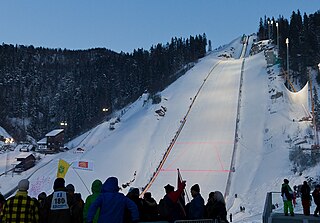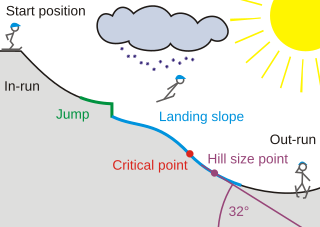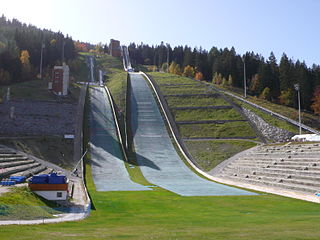
Nordic combined is a winter sport in which athletes compete in cross-country skiing and ski jumping. The Nordic combined at the Winter Olympics has been held since the first ever Winter Olympics in 1924, while the FIS Nordic Combined World Cup has been held since 1983. Many Nordic combined competitions use the Gundersen method, where placement in the ski jumping segment results in time (dis)advantages added to the contestant's total in the cross-country skiing segment.

Ski jumping is a winter sport in which competitors aim to achieve the farthest jump after sliding down on their skis from a specially designed curved ramp. Along with jump length, competitor's aerial style and other factors also affect the final score. Ski jumping was first contested in Norway in the late 19th century, and later spread through Europe and North America in the early 20th century. Along with cross-country skiing, it constitutes the traditional group of Nordic skiing disciplines.

Holmenkollbakken is a large ski jumping hill located at Holmenkollen in Oslo, Norway. It has a hill size of HS134, a construction point of K-120, and a capacity for 70,000 spectators. Holmenkollen has hosted the Holmenkollen Ski Festival since 1892, which since 1980 have been part of the FIS Ski Jumping World Cup and 1983 the FIS Nordic Combined World Cup. It has also hosted the 1952 Winter Olympics and the FIS Nordic World Ski Championships in 1930, 1966, 1982 and 2011.

Simon Ammann is a Swiss ski jumper. He is one of the most successful athletes in the history of the sport, having won four individual Winter Olympic gold medals in 2002 and 2010. His other achievements include winning the 2007 Ski Jumping World Championships, the 2010 Ski Flying World Championships, the 2010 Nordic Tournament, and the 2010 Ski Jumping World Cup overall title.
Masahiko Harada is a Japanese former ski jumper. He is best remembered for a meltdown at the 1994 Winter Olympics in Lillehammer, which cost the Japanese national team a victory, and his subsequent redemption at the 1998 Winter Olympics in Nagano; the latter of which led to him being affectionately called "Happy Harada".

Noriaki Kasai is a Japanese ski jumper. His career achievements include a gold medal at the 1992 Ski Flying World Championships, winning the 1999 Nordic Tournament, individual silver medal at the 2014 Winter Olympics, and two individual bronze medals at the 2003 Ski Jumping World Championships.

Lysgårdsbakken, officially known as Lysgårdsbakkene Ski Jumping Arena, is a ski jumping hill in Lillehammer, Norway. It consists of a large hill, with a K-point of 123 and a hill size of 138, and a small hill with a K-point of 90 and a hill size of 100. It opened in 1993 for the 1994 Winter Olympics, where it hosted the ski jumping and Nordic combined events, as well as the opening and closing ceremonies. After the Olympics, ownership was transferred to the municipal Lillehammer Olympiapark and it has since been used for several FIS Ski Jumping World Cup and FIS Nordic Combined World Cup tournaments, including hosting the Nordic Tournament. It has a capacity for 35,000 spectators and is one of three national ski jumping hills in Norway. In 2007, the large hill was rebuilt to a larger profile, and received a new plastic lining. The venue sees 80,000 annual jumps in the winter and 20,000 in the summer season.

The Nordic combined events have been contested at the Winter Olympic Games since 1924. The first competition involved 18 km cross-country skiing, followed by ski jumping.

Vikersundbakken or Vikersund Hill is a ski flying hill at Vikersund in Modum, Norway. It is one of the two largest purpose-built ski flying hills in the world. Nine world records have been set there, including the current record of 253.5 meters, set by Stefan Kraft. The complex consists of a large hill, a normal hill and several training hills.

The Lake Placid Olympic Ski Jumping Complex, also known as the MacKenzie Intervale Ski Jumping Complex, consists of HS100- and HS128-meter ski jump towers built for the 1980 Olympic Games in Lake Placid, New York, United States. Modernized and lengthened in 2021, they are the only jumps in North America homologated for winter and summer jumping competitions. The complex is operated by the Olympic Regional Development Authority.

Trampolino Olimpico Italia is a ski jumping hill (K90), built in 1955 in Cortina d'Ampezzo, Italy. It was the site of the ski jumping, Nordic combined (K90/15.0) and team events for the 1956 Winter Olympics. The Nordic combined event used a shorter in-run to allow average jumps between 60 and 70 meters while the upper starting points on the in-run were calculated to allow jumps of 70 to 80 meters. The 1956 profile had a safety limit of 14.5 m beyond the critical point of 72 m.. Among many national and international competitions starting with the 1927 World Championships, was the inauguration of the FIS Ski Jumping World Cup in 1979. Since the venue lost its FIS-certification in 1990, the installation lies dormant. In its day, the Cortina Ski Jumping hill was regarded as one of the most innovative and still today as one of the most architecturally beautiful examples still in existence. The stadium holds a maximum of 40,000 spectators in the arena and an additional 10.000 in the stands on each side of the hill.
At the FIS Nordic World Ski Championships 2009 in Liberec, Czech Republic, four Nordic combined were held. It also showed the biggest format changes since the introduction of the Gundersen method at the 1985 World Championships in Seefeld, Austria. In addition to the 10 km mass start event, there were changes in the Gundersen-based individual events. The 7.5 km sprint event was changed to a 10 km individual large hill event while the 15 km individual event was changed to a 10 km individual normal hill event with both being approved in September 2008. These changes also affected the Nordic combined program for the 2010 Winter Olympics in Vancouver though the mass start was excluded. The United States, which had two medals in Nordic combined prior to this championships, won a total of four medals with three golds and a bronze. Todd Lodwick, whose previous best individual finish at the world championships was 13th in the 7.5 km sprint at Oberstdorf in 2005, won golds in the 10 km mass start and 10 km individual normal hill events. His teammate Bill Demong won a gold in the 10 km individual large hill and bronze in the 10 km individual normal hill events. Germans Tino Edelmann and Björn Kircheisen each won a silver in the 4 x 5 km freestyle team event, then won individual silver medals in the 10 km mass start and 10 km individual large hills events, respectively. France's Jason Lamy Chappuis earned two bronze medals, earning them in the 10 km individual large hill and 10 km mass start. Norway's Jan Schmid won a silver in the 10 km mass start and a bronze in the 4 x 5 km freestyle event. A fourth American medal was prevented when Demong was disqualified in the ski jumping part of the 4 x 5 km freestyle team event for failing to wear his bib during competition, dropping the US to 12th and forcing their withdrawal from the cross country portion of the event. The Japanese won their first gold medal at the championships in the team event since 1995 when they edged the Germans in a photo finish. Current World Cup leader Anssi Koivuranta of Finland has a disappointing world championships, earning his best finish of fourth both in the 10 km individual normal hill and 10 km mass start events. Norway's Magnus Moan, second in the World Cup standings, also had a disappointing championships as well, with a best place finish of fifth in the 10 km individual large hill events even though he set the fastest cross-country skiing portion time in both the 10 km individual large hill and the 10 km individual normal hill events.

The hill size (HS) is the most important measurement for the size of a ski jumping hill. It is defined as the distance between the takeoff table and the end of the landing area, which is called hill size point. It is not measured as a straight line but on the surface of the hill.

The construction point, also known as the K-point or K-spot and formerly critical point, is a line across a ski jumping hill. It is used to calculate the number of points granted for a given jump. It is therefore also called calculation point or calculation line.

Tremplin du Praz is a ski jumping hill at Le Praz in Courchevel, France. The complex consists of four hills: a large hill with construction point of K125 (HS137), a normal hill at K90 (HS96), and two training hills at K60 and K25. The complex also has a cross-country skiing stadium used for Nordic combined. Jörg Ritzerfeld holds the large hill winter record of 134.0 metres and Nicolas Mayer the normal hill record of 100.5 metres.

Igman Olympic Jumps, also known as Malo Polje, is a defunct ski jumping hill on the mountain of Igman in Ilidža, Sarajevo, Bosnia and Herzegovina. It consists of a large hill with a construction point (K-point) of 112 meters (367 ft) and a normal hill with a K-point of 90 meters (295 ft). Construction started in 1980 and the venue opened in 1982 to host ski jumping and Nordic combined at the 1984 Winter Olympics. The large hill event saw Finland's Matti Nykänen set the hill record of 116.0 meters (381 ft) in front of 90,000 spectators. No other International Ski Federation (FIS) sanctioned competitions have taken place at the hills. During the Siege of Sarajevo, the hills became a battleground and have since not been used. However, there are plans to rebuild the in-run, expand the large hill and build new spectator stands and visitor facilities.

Carina Vogt is a German former ski jumper.

The "Giuseppe Dal Ben" Ski Jumping Arena is a ski jumping venue in Predazzo, Val di Fiemme, Trentino, in northern Italy. It is a venue in the FIS Ski jumping World Cup.














